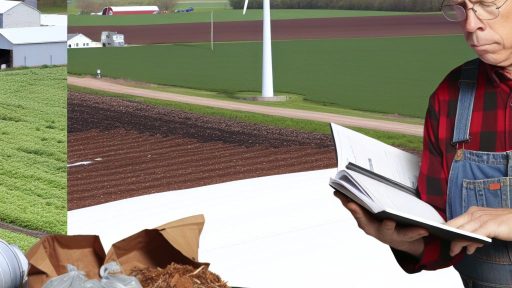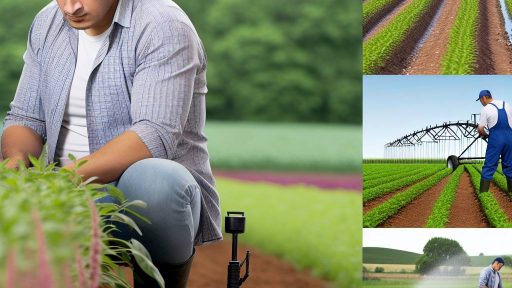Introduction to Buffer Zones
Definition of Buffer Zones
Buffer zones are designated areas between sensitive environments and chemical application sites.
They serve as protective barriers against chemical drift.
By creating distance, buffer zones help minimize negative environmental impacts.
They also protect wildlife and human health.
Purpose of Buffer Zones
The primary purpose of buffer zones is to safeguard water sources.
These zones prevent chemicals from reaching rivers and lakes.
Additionally, they reduce exposure risks for neighboring communities.
Buffer zones promote compliance with environmental regulations.
Implementation Considerations
Implementing effective buffer zones requires careful planning.
Factors such as wind patterns and chemical properties are crucial.
Consulting scientific research and guidelines helps ensure effectiveness.
Furthermore, involving local stakeholders fosters community support.
Benefits of Buffer Zones
Buffer zones provide ecological benefits by supporting biodiversity.
These areas can serve as habitats for various species.
Moreover, they enhance soil stability and prevent erosion.
Transform Your Agribusiness
Unlock your farm's potential with expert advice tailored to your needs. Get actionable steps that drive real results.
Get StartedBuffer zones contribute to sustainable agricultural practices.
Importance of Buffer Zones in Agricultural Practices
Enhancing Environmental Protection
Buffer zones play a crucial role in environmental protection within agricultural settings.
They reduce the runoff of pesticides and fertilizers into nearby waterways.
This minimizes contamination risks for aquatic ecosystems.
Moreover, buffer zones provide habitats for wildlife, enhancing biodiversity.
Improving Soil Quality
Buffer zones contribute to better soil quality on agricultural land.
They prevent soil erosion by stabilizing the soil structure.
Additionally, they enhance soil organic matter, improving fertility.
This results in healthier crops and increased agricultural productivity.
Regulating Water Flow
Effective buffer zones help in regulating water flow across farm fields.
They absorb excess rainwater, reducing the risk of flooding.
This promotes sustainable water management in agricultural practices.
Furthermore, they help recharge groundwater supplies over time.
Supporting Crop Management
Buffer zones assist in better crop management techniques.
They create microclimates that can benefit certain crops.
For instance, they can provide shade to reduce heat stress on plants.
Additionally, pest populations are controlled due to natural predator habitats.
Compliance with Regulations
Implementing buffer zones often aligns with agricultural regulations.
Many countries mandate buffer zones to protect sensitive areas.
Farmers can avoid legal issues while promoting sustainable practices.
Compliance can lead to financial incentives for better practices.
Regulatory Guidelines for Chemical Application Near Sensitive Areas
Introduction to Regulatory Guidelines
Regulatory guidelines play a crucial role in chemical applications.
These guidelines ensure the safety of sensitive environments.
Additionally, they provide a framework for responsible practices.
Showcase Your Farming Business
Publish your professional farming services profile on our blog for a one-time fee of $200 and reach a dedicated audience of farmers and agribusiness owners.
Publish Your ProfileUnderstanding Sensitive Areas
Sensitive areas include ecosystems that are vulnerable to chemical exposure.
These areas consist of watersheds, wetlands, and habitats for endangered species.
Protecting these environments is vital for maintaining biodiversity.
Key Regulatory Frameworks
Various regulations govern how chemicals can be applied near sensitive areas.
The Environmental Protection Agency (EPA) provides major guidelines.
Local and state regulations may also influence chemical usage.
Overview of EPA Regulations
The EPA establishes rules to protect human health and the environment.
These regulations include limits on chemical types and application methods.
Furthermore, adherence to safety data sheets is essential.
State and Local Oversight
State agencies often reinforce federal regulations with additional rules.
Local authorities may mandate buffer zones or specific application techniques.
Compliance with these higher standards promotes overall environmental protection.
Buffer Zones Implementation
Buffer zones act as protective barriers against chemical drift.
These zones reduce the risk of harm to sensitive areas.
Establishing effective buffer zones requires careful planning and assessment.
Determining Buffer Zone Size
The appropriate size of buffer zones depends on various factors.
Considerations include the type of chemical used and application methods.
Additionally, local environmental conditions significantly influence this decision.
Monitoring and Compliance
Regular monitoring ensures compliance with established guidelines.
Documentation of chemical usage is also essential for accountability.
Furthermore, training for applicators promotes effective implementation of guidelines.
Best Practices for Safe Chemical Use
Implementing buffer zones is a critical step for safe chemical application.
Adhering to regulatory guidelines protects sensitive areas effectively.
These practices foster a more sustainable approach to agriculture.
You Might Also Like: Exploring Rural Development Policies That Benefit Modern Farmers
Types of Buffer Zones
Widths of Buffer Zones
Buffer zones come in various widths to meet specific needs.
The width depends on the type of chemical application and surrounding areas.
For example, agricultural buffers often range from 10 to 50 feet.
In contrast, industrial sites may require wider zones, reaching up to 100 feet.
Wider zones generally offer better protection against chemical drift.
Vegetation in Buffer Zones
Vegetation plays a crucial role in the effectiveness of buffer zones.
Diverse plant species can enhance filtration of chemicals.
Grasses, shrubs, and trees work together to absorb contaminants.
Moreover, native plants often provide natural resilience against pests.
They also support local wildlife, promoting biodiversity.
Structure of Buffer Zones
Buffer zones may vary in structure depending on their purpose.
Physical barriers like fences or berms can strengthen protection.
These structures often reduce the speed of wind and water runoff.
Additionally, they help prevent soil erosion in vulnerable areas.
Incorporating drainage systems within buffer zones can enhance efficiency.
Showcase Your Farming Business
Publish your professional farming services profile on our blog for a one-time fee of $200 and reach a dedicated audience of farmers and agribusiness owners.
Publish Your ProfileDiscover More: Impact of Farm-To-Table Regulations on Local Agriculture and Farmers
Designing Effective Buffer Zones
Key Considerations
Understanding the purpose of buffer zones is crucial for effective design.
They serve as a protective measure for fragile ecosystems.
Additionally, they can help mitigate the impact of chemical applications.
Effective buffer zones consider surrounding land use and ecological needs.
Moreover, they require thorough site assessments and planning.
Environmental Considerations
Selecting native vegetation is essential for creating effective buffer zones.
Native plants support local wildlife and promote biodiversity.
Incorporating diverse plant species enhances resilience against pests.
Furthermore, understanding soil types helps with vegetation selection.
Soil health is critical for the success of buffer zones.
Regulatory Compliance
Compliance with local and federal regulations is vital.
Consulting regulatory guidelines ensures that buffer zones are established correctly.
Documentation of chemical usage and its impact must be maintained.
Additionally, obtaining permits may be necessary for specific applications.
Maintenance Practices
Routine maintenance is integral to buffer zone effectiveness.
Regular inspections help identify invasive species and other issues.
Implementing controlled burns can promote native plant growth.
Moreover, proper irrigation practices should be ensured during dry spells.
Fostering community involvement enhances maintenance efforts.
Best Practices for Implementation
Establishing clear objectives is the first step in implementation.
Developing a comprehensive plan involves consultation with stakeholders.
Utilizing technology for monitoring can enhance management efforts.
Creating educational resources raises awareness about the importance of buffer zones.
Finally, evaluating the effectiveness of buffer zones informs future adjustments.
Learn More: Conservation Programs Enhancing Soil Health On Farms
Case Studies: Successful Implementation of Buffer Zones
Introduction to Buffer Zones
Buffer zones play a crucial role in chemical applications.
They act as protective barriers that reduce environmental risks.
Moreover, they help in minimizing contamination of nearby areas.
Case Study: Greenfield Chemical Company
Greenfield Chemical Company successfully adopted buffer zones in 2022.
They created a 50-meter buffer zone around their production site.
This decision aimed to protect local water sources from chemical spills.
Consequently, water quality improved significantly.
Residents reported enhanced safety and lower health concerns.
Case Study: Riverside Agriculture Partnership
The Riverside Agriculture Partnership established buffer zones in farmland.
They employed vegetative buffer strips to intercept runoff.
This approach successfully reduced pesticide drift.
Farmers noted a significant increase in crop yield.
Overall, the local ecosystem thrived with increased biodiversity.
Case Study: Clearwater Industrial Zone
Clearwater Industrial Zone implemented a comprehensive buffer strategy.
Showcase Your Farming Business
Publish your professional farming services profile on our blog for a one-time fee of $200 and reach a dedicated audience of farmers and agribusiness owners.
Publish Your ProfileThey created zones around hazardous material storage facilities.
Regular monitoring ensured the effectiveness of the buffer zones.
Moreover, the local community experienced decreased pollution levels.
This initiative bolstered public trust in industrial operations.
Implications for Future Chemical Applications
These case studies demonstrate the effectiveness of buffer zones.
They highlight the importance of proactive environmental strategies.
As a result, companies are encouraged to adopt similar practices.
Ultimately, these implementations benefit both the environment and public health.
You Might Also Like: Maximizing Farm Profits Through Understanding Trade Agreements

Monitoring and Maintenance of Buffer Zones for Longevity
Importance of Regular Monitoring
Regular monitoring of buffer zones is crucial for their effectiveness.
Routine checks identify potential issues before they escalate.
This proactive approach helps maintain ecological integrity.
Additionally, it promotes compliance with regulatory standards.
Effective Maintenance Practices
Implementing effective maintenance practices ensures buffer zone longevity.
Regular mowing prevents invasive species from dominating the area.
Weeding and removing debris further promote healthy vegetation.
Moreover, periodic soil tests assess nutrient levels and pH balance.
Documentation and Reporting
Accurate documentation of findings aids in assessing buffer performance.
It is essential to log all maintenance activities and observations.
Reporting these findings can benefit future planning and decision-making.
Community Involvement
Engaging the community fosters a sense of ownership over buffer zones.
Educational workshops can raise awareness about their significance.
Volunteers can assist with maintenance efforts, enhancing community bonds.
These collaborative efforts may lead to increased funding and resources.
Adaptive Management Strategies
Adaptive management involves adjusting strategies based on monitoring results.
Flexibility allows for a dynamic response to changing environmental conditions.
This approach can optimize buffer zone performance over time.
Continual learning informs best practices and successful implementations.
Challenges and Limitations in Implementing Buffer Zones
Understanding Buffer Zones
Buffer zones serve as protective barriers in chemical applications.
They help minimize the risk of contamination and exposure.
However, their implementation is often complex and challenging.
Regulatory Hurdles
Regulatory compliance presents a significant challenge.
Different regions have varying requirements for buffer zones.
This inconsistency complicates uniform implementation.
Companies must invest time and resources to ensure compliance.
Failure to meet regulations may result in severe penalties.
Environmental Considerations
Environmental conditions can affect buffer zone effectiveness.
Weather patterns may influence the dispersion of chemicals.
Land use changes can also impact buffer zone viability.
Thus, adaptability becomes essential for successful implementation.
Showcase Your Farming Business
Publish your professional farming services profile on our blog for a one-time fee of $200 and reach a dedicated audience of farmers and agribusiness owners.
Publish Your ProfileEconomic Constraints
The cost of establishing buffer zones can be prohibitive.
Many companies struggle to allocate sufficient budgets for this purpose.
Additionally, ongoing maintenance adds to financial burdens.
Such economic challenges often deter businesses from adopting these practices.
Land Use Conflicts
Buffer zones might require land that is already in use.
This creates conflicts between agricultural practices and conservation efforts.
Stakeholder engagement is crucial during the planning stages.
Collaboration can help address differing land use priorities.
Public Perception and Awareness
Public understanding of buffer zones remains limited.
Many people are unaware of their benefits and purpose.
This lack of awareness may lead to resistance against implementation.
Effective communication can bridge this gap.
Education initiatives can foster a deeper understanding.
Future Trends: Innovations in Buffer Zone Management and Technology
Emerging Technologies for Buffer Zone Monitoring
Recent advancements are revolutionizing buffer zone management.
Innovative monitoring technologies enhance data collection capabilities.
For example, drones provide aerial surveillance of designated areas.
This technology allows for real-time assessment of environmental conditions.
Furthermore, satellite imagery offers broader landscape analysis.
These tools enable quicker response times to pollution events.
Additionally, remote sensors improve chemical detection accuracy.
Integration of AI and Machine Learning
Artificial intelligence plays a vital role in buffer zone management.
AI algorithms analyze data collected from different sources.
This analysis identifies potential risks and trends effectively.
Machine learning models can predict adverse environmental events.
Through these predictions, managers can implement preventive measures.
Ultimately, this leads to improved decision-making processes.
Developments in Eco-friendly Materials
New eco-friendly materials are entering the buffer zone design landscape.
These materials enhance ecological health while minimizing pollutants.
Biodegradable barriers are gaining attention in industrial applications.
Moreover, plants that naturally absorb toxins are being introduced.
This approach fosters a sustainable and healthy environment.
Collaborative Approaches to Buffer Zone Management
Community involvement is essential for effective buffer zone strategies.
Partnerships between industries and local governments yield positive outcomes.
Stakeholder engagement encourages shared responsibility for environmental health.
Moreover, educational programs raise awareness about the importance of buffer zones.
Such collaboration fosters innovation and sustainable practices.
Regulatory Changes and Their Impact
New regulations shape the future of buffer zone management.
Stricter guidelines promote safer chemical usage practices.
Compliance with these regulations ensures better environmental outcomes.
Furthermore, policymakers are incentivizing innovative technologies.
Showcase Your Farming Business
Publish your professional farming services profile on our blog for a one-time fee of $200 and reach a dedicated audience of farmers and agribusiness owners.
Publish Your ProfileThese changes drive the industry toward sustainable solutions.
Additional Resources
Wetland Guidance for Critical Area Ordinance (CAO) Updates
Best Management Practices To Minimize Agricultural Phosphorus …




